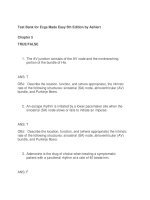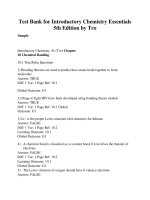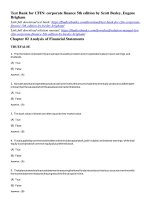Download PDF test bank for ecgs made easy 5th edition by aehlert
Bạn đang xem bản rút gọn của tài liệu. Xem và tải ngay bản đầy đủ của tài liệu tại đây (499.25 KB, 28 trang )
Test Bank for Ecgs Made Easy 5th Edition by Aehlert
Chapter 5
TRUE/FALSE
1. The AV junction consists of the AV node and the nonbranching
portion of the bundle of His.
ANS: T
OBJ: Describe the location, function, and (where appropriate), the intrinsic
rate of the following structures: sinoatrial (SA) node, atrioventricular (AV)
bundle, and Purkinje fibers.
2. An escape rhythm is initiated by a lower pacemaker site when the
sinoatrial (SA) node slows or fails to initiate an impulse.
ANS: T
OBJ: Describe the location, function, and (where appropriate) the intrinsic
rate of the following structures: sinoatrial (SA) node, atrioventricular (AV)
bundle, and Purkinje fibers.
3. Adenosine is the drug of choice when treating a symptomatic
patient with a junctional rhythm at a rate of 40 beats/min.
ANS: F
Atropine (not adenosine) is the drug of choice when treating a symptomatic
patient with a junctional rhythm at a rate of 40 beats/min.
OBJ: Describe the ECG characteristics, possible causes, signs and
symptoms, and initial emergency care for a junctional escape rhythm.
4. The pacemaker cells in the AV junction are located near
the nonbranching portion of the bundle of His.
ANS: T
OBJ: Describe the location, function, and (where appropriate) the intrinsic
rate of the following structures: sinoatrial (SA) node, atrioventricular (AV)
bundle, and Purkinje fibers.
MULTIPLE CHOICE
1. A beat originating from the AV junction that appears later than the
next expected sinus beat is called a _____.
a.
junctional escape beat
b.
period of SA block
c.
premature junctional complex (PJC)
d.
premature atrial complex (PAC)
ANS: A
Junctional complexes may come early (before the next expected sinus beat)
or late (after the next expected sinus beat). If the complex is early, it is called
a premature junctional complex. If the complex is late, it is called a junctional
escape beat. To determine whether a complex is early or late, you need to
see at least two sinus beats in a row to establish the regularity of the
underlying rhythm.
OBJ: Explain the difference between premature junctional complexes and
junctional escape beats.
2. Which of the following medications increases heart rate by accelerating
the SA node discharge rate and blocking the vagus nerve?
a.
Digitalis
b.
Atropine
c.
Amiodarone
d.
Beta-blocker
ANS: B
Atropine is a vagolytic drug that is used to increase the heart rate. Vago
refers to the vagus nerves (right and left), which are the main nerves of the
parasympathetic division of the autonomic nervous system. Lytic refers to
“lyse,” which meansrfere“towithinte.” Atropine works by blocki acetylcholine at the endings
of the vagus nerves. The vagus nerves innervate
the heart at the SA and AV nodes. Thus, atropine is most effective for narrowQRS bradycardia. By blocking the effects of acetylcholine, atropine allows
more activity from the sympathetic division of the autonomic nervous system.
As a result, the rate at which the SA node can fire is increased. Areas of the
heart that are not innervated or that are minimally innervated by the vagus
nerves (e.g., the ventricles) will not respond to atropine. Thus, atropine is
usually ineffective for the treatment of wide-QRS bradycardia. Atropine also
increases the rate at which an impulse is conducted through the AV node. It
has little or no effect on the force of contraction.
OBJ: Describe the ECG characteristics, possible causes, signs and
symptoms, and initial emergency care for a junctional escape rhythm.
3. In a junctional rhythm viewed in lead II, where is the location of the P
wave on the ECG if atrial and ventricular depolarization occur
simultaneously?
a.
Before the QRS complex
b.
During the QRS complex
c.
After the QRS complex
ANS: B
If the atria and ventricles depolarize at the same time, a P wave will not
be visible because it will be hidden in the QRS complex.
OBJ: Describe the ECG characteristics, possible causes, signs and
symptoms, and initial emergency care for a junctional escape rhythm.
4. Common causes of junctional dysrhythmias may include acute
coronary syndromes and _____.
a.
hyperthyroidism
b.
hypovolemia
c.
digitalis toxicity
d.
hypoxia
ANS: C
Toxicity or excess of digitalis is a common cause of junctional dysrhythmias.
OBJ: Describe the ECG characteristics, possible causes, signs and
symptoms, and initial emergency care for a junctional escape rhythm.
5. Identify the following rhythm (lead II).
a.
Accelerated junctional rhythm
b.
Sinus rhythm
c.
Junctional rhythm
d.
Sinus arrhythmia
ANS: A
The rhythm strip shows an accelerated junctional rhythm.
OBJ: Describe the ECG characteristics, possible causes, signs and
symptoms, and initial emergency care for an accelerated junctional rhythm.
6. Identify the following rhythm (lead II).
a.
Sinus arrhythmia
b.
Sinus rhythm with junctional escape beats
c.
Sinus tachycardia with premature atrial complexes
d.
Sinus tachycardia with premature
junctional complexes
ANS: D
The rhythm strip shows a sinus tachycardia with premature junctional
complexes.
OBJ: Describe the ECG characteristics, possible causes, signs and
symptoms, and initial emergency care for premature junctional
complexes (PJCs).
7. Identify the following rhythm (lead II).
a.
Junctional tachycardia
b.
Sinus rhythm with PACs
c.
Sinus rhythm with PJCs
d.
Accelerated junctional rhythm
ANS: D
The rhythm strip shows an accelerated junctional rhythm.
OBJ: Describe the ECG characteristics, possible causes, signs and
symptoms, and initial emergency care for an accelerated junctional rhythm.
8. A junctional escape rhythm occurs because of _____.
a.
severe chronic obstructive pulmonary disease
b.
multiple irritable sites firing within the AV junction
c.
slowing of the rate of the hear pacemaker
d.
intrathoracic pressure changes associated
with the normal respiratory cycle
ANS: C
The atrioventricular (AV) junction may assume responsibility for pacing the
heart if (1) the sinoatrial (SA) node fails to discharge (such as sinus arrest),
(2) an impulse from the SA node is generated but blocked as it exits the SA
node (such as SA block), (3) the rate of discharge of the SA node is slower
than that of the AV junction (such as a sinus bradycardia or the slower phase
of a sinus arrhythmia), and (4) an impulse from the SA node is generated
and is conducted through the atria, but is not conducted to the ventricles
(such as an AV block).
OBJ: Describe the ECG characteristics, possible causes, signs and
symptoms, and initial emergency care for a junctional escape rhythm.
9. In a junctional rhythm viewed in lead II, where is the location of the P
wave on the ECG if atrial depolarization precedes ventricular
depolarization?
a.
Before the QRS complex
b.
During the QRS complex
c.
After the QRS complex
ANS: A
If the AV junction paces the heart and the atria depolarize before the
ventricles, an inverted P wave will be seen before the QRS complex and the
PR interval will usually measure 0.12 seconds or less. The PR interval is
shorter than usual because an impulse that begins in the AV junction does
not have to travel as far to stimulate the ventricles.
OBJ: Describe the ECG characteristics, possible causes, signs and
symptoms, and initial emergency care for a junctional escape rhythm.
10.
The usual rate of nonparoxysmal junctional tachycardia is _____
beats/min.
a.
50 to 80
b.
80 to 120
c.
101 to 140
d.
150 to 300
ANS: C
Nonparoxysmal (i.e., gradual onset) junctional tachycardia usually starts as
an accelerated junctional rhythm, but the heart rate gradually increases to
more than 100 beats/min. The usual ventricular rate for nonparoxysmal
junctional tachycardia is 101 to 140 beats/min.
OBJ: Describe the ECG characteristics, possible causes, signs and
symptoms, and initial emergency care for junctional tachycardia.
11.
The atrioventricular (AV) junction consists of the _____.
a.SA and AV nodes
b.
AV node and the Purkinje fibers
c.
AV node and nonbranching portion of the
bundle of His
d.
AV node, bundle of His, and the right and
left bundle branches
ANS: C
The AV node and the nonbranching portion of the bundle of His are called
the AV junction. The bundle of His has pacemaker cells that are capable
of discharging at a rhythmic rate of 40 to 60 beats/min.
OBJ: Describe the location, function, and (where appropriate) the intrinsic
rate of the following structures: sinoatrial (SA) node, atrioventricular (AV)
bundle, and Purkinje fibers.
12.
If seen, the P wave of a rhythm originating in the AV junction
will appear _____ in lead II.
a.
upright
b.
inverted
c.
tall and peaked
d.
wide and notched
ANS: B
If the AV junction paces the heart, the electrical impulse must travel in a
backward (retrograde) direction to activate the atria. If a P wave is seen, it will
be inverted in leads II, III, and aVF because the impulse is traveling away
from the positive electrode.
OBJ: Describe the ECG characteristics, possible causes, signs and
symptoms, and initial emergency care for a junctional escape rhythm.
13.
Depending on the severity of the patient’s sig management of slow rhythms
originating from the AV junction may
require intervention including _____.
a.
defibrillation
b.
intravenous atropine
c.
synchronized cardioversion
d.
vagal maneuvers or adenosine, or both
ANS: B
Atropine, administered intravenously, is the drug of choice for symptomatic
bradycardia. Defibrillation, synchronized cardioversion, vagal maneuvers, and
adenosine are not indicated in the treatment of slow cardiac rhythms.
OBJ: Describe the ECG characteristics, possible causes, signs and
symptoms, and initial emergency care for a junctional escape rhythm.
COMPLETION
1. A(n) _____ pause often follows a PJC and represents the delay
during which the SA node resets its rhythm for the next beat.
ANS: noncompensatory
OBJ: Explain the difference between a compensatory and noncompensatory
pause.
2. If the AV junction paces the heart, the electrical impulse must travel in a
backward direction to activate the atria. This is called _____ conduction.
ANS: retrograde
OBJ: Explain the difference between premature junctional complexes and
junctional escape beats.
3. A beat originating from the AV junction that appears later than the
next expected sinus beat is called a(n) _____ _____ _____.
ANS: junctional escape beat
OBJ: Explain the difference between premature junctional complexes and
junctional escape beats.
SHORT ANSWER
1. Identify the following rhythm (lead II): ____________________
ANS:
Sinus tachycardia at 136 beats/min with frequent PJCs (the PJCs are beats
2, 5, 8, and 11 from the left)
OBJ: Describe the ECG characteristics, possible causes, signs and
symptoms, and initial emergency care for premature junctional
complexes (PJCs).
2. Identify the following rhythm (lead II): ____________________
ANS:
Accelerated junctional rhythm at 75 beats/min
OBJ: Describe the ECG characteristics, possible causes, signs and
symptoms, and initial emergency care for an accelerated junctional rhythm.
3. Identify the following rhythm (lead II): ____________________
ANS:
Sinus rhythm at 75 beats/min
OBJ: Describe the ECG characteristics of a sinus rhythm.
4. Identify the following rhythm (lead II): ____________________
ANS:
Sinus rhythm changing to an accelerated junction rhythm at 79 beats/min
back to a sinus rhythm
OBJ: Describe the ECG characteristics, possible causes, signs and
symptoms, and initial emergency care for an accelerated junctional rhythm.
5. Identify the following rhythm (lead II): ____________________
ANS:
Sinus rhythm at 94 beats/min with a PAC (second beat from left) and a
junctional escape beat (third beat from left)
OBJ: Describe the ECG characteristics and possible causes for junctional
escape beats.
6. Identify the following rhythm (lead II): ____________________
ANS:
Sinus tachycardia at 115 beats/min with a PJC (beat 5 is the PJC)
OBJ: Describe the ECG characteristics, possible causes, signs and
symptoms, and initial emergency care for premature junctional
complexes (PJCs).
7. Identify the following rhythm (lead II): ____________________
ANS:
Junctional escape rhythm at 52 beats/min with elevated T waves
OBJ: Describe the ECG characteristics, possible causes, signs and
symptoms, and initial emergency care for a junctional escape rhythm.
8. Identify the following rhythm (lead II): ____________________
ANS:
Junctional rhythm at 45 beats/min; ST segment elevation
OBJ: Describe the ECG characteristics, possible causes, signs and
symptoms, and initial emergency care for a junctional escape rhythm.
9. Identify the following rhythm (lead II): ____________________
ANS:
Junctional rhythm at 37 beats/min converting to a sinus rhythm
OBJ: Describe the ECG characteristics, possible causes, signs and
symptoms, and initial emergency care for a junctional escape rhythm.
10.
Identify the following rhythm (lead II): ____________________
ANS:
Accelerated junctional rhythm at 83 beats/min
OBJ: Describe the ECG characteristics, possible causes, signs and
symptoms, and initial emergency care for an accelerated junctional rhythm.
11.
Identify the following rhythm (lead II): ____________________
ANS:
Sinus tachycardia at 125 beats/min changing to a junctional tachycardia at
125 beats/min
OBJ: Describe the ECG characteristics, possible causes, signs and
symptoms, and initial emergency care for junctional tachycardia.
12.
Identify the following rhythm: ____________________
ANS:
Junctional rhythm at 44 beats/min; ST segment elevation
OBJ: Describe the ECG characteristics, possible causes, signs and
symptoms, and initial emergency care for a junctional escape rhythm.
13.
Identify the following rhythm (lead II): ____________________
ANS:
Narrow-QRS tachycardia (probably junctional tachycardia) at 138 beats/min
OBJ: Describe the ECG characteristics, possible causes, signs and
symptoms, and initial emergency care for junctional tachycardia.
14.
Identify the following rhythm (lead II): ____________________
ANS:
Accelerated junctional rhythm at 100 beats/min
OBJ: Describe the ECG characteristics, possible causes, signs and
symptoms, and initial emergency care for an accelerated junctional rhythm.
15.
Identify the following rhythm: ____________________
ANS:
Sinus rhythm at 63 beats/min with PJCs (junctional trigeminy)
OBJ: Describe the ECG characteristics, possible causes, signs and
symptoms, and initial emergency care for premature junctional complexes
(PJCs).
16.
Identify the following rhythm: ____________________
ANS:
Sinus bradycardia at 33 beats/min to junctional bradycardia at 32 beats/min
OBJ: Describe the ECG characteristics, possible causes, signs and
symptoms, and initial emergency care for a junctional escape rhythm.
17.
Identify the following rhythm: ____________________
ANS:
Atrial flutter at 58 to 79 beats/min
OBJ: Describe the ECG characteristics, possible causes, signs and
symptoms, and initial emergency care for atrial flutter.
18.
Identify the following rhythm: ____________________
ANS:
Accelerated junctional rhythm at 75 beats/min; ST-segment depression
OBJ: Describe the ECG characteristics, possible causes, signs and
symptoms, and initial emergency care for an accelerated junctional rhythm.
19.
Identify the following rhythm (lead II): ____________________
ANS:
Sinus rhythm at 70 beats/min with a nonconducted PAC (note distortion of
the T wave of the beat preceding the pause) and a junctional escape beat
OBJ: Describe the ECG characteristics and possible causes for junctional
escape beats.
20.
Identify the following rhythm (lead II): ____________________
ANS:
Junctional bradycardia at 30 beats/min to sinus bradycardia at 56 beats/min
OBJ: Describe the ECG characteristics, possible causes, signs and
symptoms, and initial emergency care for a junctional escape rhythm.
21.
Identify the following rhythm (lead II): ____________________
ANS:
Sinus rhythm at 90 beats/min with a PJC
OBJ: Describe the ECG characteristics, possible causes, signs and
symptoms, and initial emergency care for premature junctional
complexes (PJCs).
22.
Identify the following rhythm (lead II): ____________________
ANS:
Atrial fibrillation at 65 to 103 beats/min
OBJ: Describe the ECG characteristics, possible causes, signs and
symptoms, and initial emergency care for atrial fibrillation.
23.
Identify the following rhythm (lead II): ____________________
ANS:
Accelerated junctional rhythm at 75 beats/min
OBJ: Describe the ECG characteristics, possible causes, signs and
symptoms, and initial emergency care for an accelerated junctional rhythm.
24.
Identify the following rhythm (lead II): ____________________
ANS:
Sinus tachycardia at 107 beats/min with a junctional escape beat (third beat
from the left) and a nonconducted PAC (buried in the T wave of the fourth
beat from the left)
OBJ: Describe the ECG characteristics and possible causes for junctional
escape beats.
25.
Identify the following rhythm (lead II): ____________________
ANS:
Sinus rhythm at 64 beats/min with an episode of sinus arrest and a
junctional escape beat
OBJ: Explain the difference between premature junctional complexes and
junctional escape beats.
26.
Identify the following rhythm (lead II): ____________________
ANS:
Junctional bradycardia with a ventricular response of 19 to 26 beats/min
OBJ: Describe the ECG characteristics, possible causes, signs and
symptoms, and initial emergency care for a junctional escape rhythm.
27.
Complete the following ECG criteria for a junctional escape
rhythm:
Rhythm
________________________________________
Rate
________________________________________
P
waves
________________________________________
PR
interval
________________________________________
QRS
duration
________________________________________
ANS:
Rhythm
Regular.
Rate
40 to 60 beats/min.
P waves
May occur before, during, or after the
QRS; if visible, the P wave is inverted in
leads II, III, and aVF.
PR
interval
If a P wave occurs before the QRS, the PR
interval will usually be 0.12 sec or less; if
no P wave occurs before the QRS, there
will be no PR interval.
QRS
duration
0.11 seconds or less unless abnormally
conducted.
OBJ: Describe the ECG characteristics, possible causes, signs and
symptoms, and initial emergency care for a junctional escape rhythm.
28.
List four reasons why the AV junction may assume
responsibility for pacing the heart.
ANS:
The AV junction may assume responsibility for pacing the heart if: (1) the SA
node fails to discharge (such as sinus arrest), (2) an impulse from the SA
node is generated but blocked as it exits the SA node (such as SA block), (3)
the rate of discharge of the SA node is slower than that of the AV junction
(such as a sinus bradycardia or the slower phase of a sinus arrhythmia), (4)
an impulse from the SA node is generated and is conducted through the
atria but is not conducted to the ventricles (such as an AV block).
OBJ: Describe the ECG characteristics, possible causes, signs and
symptoms, and initial emergency care for a junctional escape rhythm.
29.
Complete the following ECG criteria for a junctional tachycardia:
Rhythm________________________________________
Rate
________________________________________
P
waves
________________________________________
PR
interval
________________________________________
QRS
duration
________________________________________
ANS:
Rhythm
Regular.
Rate
101 to 180 beats/min.









